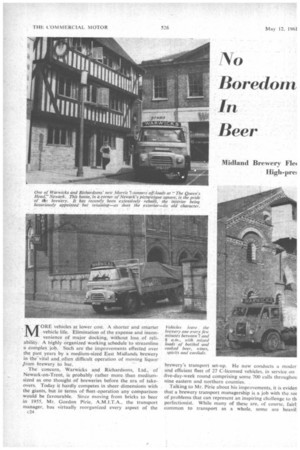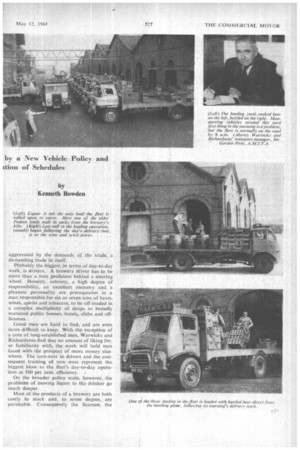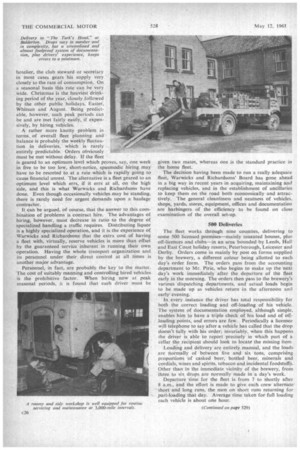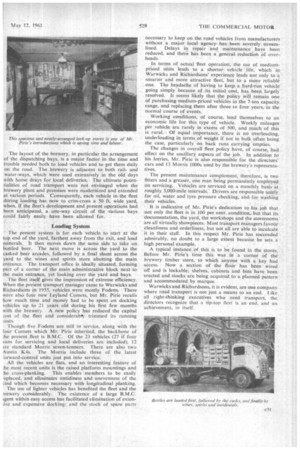M ORE vehicles at lower cost. A shorter and smarter vehicle
Page 60

Page 61

Page 62

Page 67

If you've noticed an error in this article please click here to report it so we can fix it.
life. Elimination of the expense and inconvenience of major docking, without loss of reliability. A highly organized working schedule to streamline a complex job. Such are the improvements effected over the past years by a medium-sized East Midlands brewery in the-vital and often difficult operation of moving liquor
.._ Iroin brewery to bar. • The concern, Warwicks and Richardsons, Ltd., of Newark-on-Trent, is probably rather more than mediumsized as one thought of breweries before the era of takeovers. Today it hardly competes in sheer dimensions with the giants, but in terms of fleet,operation any comparison would be favourable. Since moving from bricks to beer in 1955. Mr. Gordon Pine, A.M.I.T.A., the transport manager, has virtually reorganized every aspect of the (.:24 brewery's transport set-up. He now conducts a moder and efficient fleet of 27 C-licensed vehicles, in service on Ave-day-week round comprising some 700 calls throughou nine eastern and northern counties. .
Talking to Mr. Pine about his improvements, it is eviden that a brewery transport managership is a job with the son of problems that can represent an inspiring challenge to th perfectionist While many of these are, of course, laid: common to transport as a whole, some are heavil:
aggravated by the demands of the trade, a demanding trade in itself.
Probably the biggest, in terms of day-to-day work, is drivers. A brewery driver has to be more than a man proficient behind a steering wheel. Honesty, sobriety, a high degree of responsibility, an excellent memory ancl a pleasant personality are prerequisites in a man responsible for six or seven tons of beers, wines, spirits and tobaccos, to be off-loaded in a complex multiplicity of drops to broadly scattered public houses, hotels, clubs and offlicences.
Good men are hard to find, and are even mare difficult to keep. With the exception of a core of long-established men, Warwicks and Richardsons find that no amount of liking for, or familiarity with, the work will hold men faced with the prospect of more money elsewhere. The turn-over in drivers and the consequent training of new ones represent the biggest blow to the fleet's day-to-day operation at 100 per cent. efficiency. ■ On the broader policy scale, however, the problems of moving liquor to the drinker go much deeper.
Most of the products of a brewery are both costly to stock and, to some degree, are perishable. Consequently the licensee, the
Delivery to "The Turk's Head," at Balderton. Drops vary in number and in complexity, but a streamlined and almost foolproof system of documentation, plus drivers' experience, keeps
errors to a minimum.
hotelier, the club steward or secretary in most cases gears his supply very closely to the rate of consumption_ On a seasonal basis this rate can be very wide. Christmas is the heaviest drinking period of the year, closely followed by the other public holidays, Easter, Whitsun and August. Being predictable, however, such peak periods can be and are met fairly easily, if expensively, by hiring vehicles.
A rather more knotty problem in terms, of overall fleet planning and balance is probably the weekly fluctuation in deliveries, which is rarely , entirely predictable. Orders obviously must be met without delay. If the fleet is geared to an optimum level which proves, say, one week in five to be too low, short-notice, spasmodic hiring may have to be resorted to at a rate which is rapidly going to cause financial unrest. The alternative is a fleet geared to an optimum level which errs, if it errs at all, on the high side, and this is what Warwicks and Richardsons have done. Even though occasionally vehicles may be standing, there is rarely need for urgent demands upon a haulage contractor.
It can be argued, of course, that the answer to this com bination of problems is contract hire. The advantages of hiring, however, must decrease in ratio to the degree of specialized handling a traffic requires. Distributing liquor is a highly specialized operation, and it is the experience of Warwicks and Richardsons that the extra cost of having a fleet with, virtually, reserve vehicles is more than offset by the guaranteed service inherent in running their own operation. Having the whole transport organization and its personnel under their direct control at all times is another major advantage.
Personnel, in fact, are probably the key to the matter. The cost of suitably manning and controlling hired vehicles is the prohibitive factor. When hiring now at peak seasonal periods, it is found that each driver must be given two mates, whereas one is the standard practice in the home fleet.
The decision having been made to run a really adequate fleet, Warwicks and Richardsons' Board has gone ahead in a big way in recent years in acquiring, maintaining and replacing vehicles, and in the establishment of ancillaries to keep them on the road both economically and attractively. The general cleanliness and neatness of vehicles, shops, yards, stores, equipment, offices and documentation are harbingers of the efficiency to be found on close examination of the overall set-up.
500 Deliveries The fleet works through nine counties, delivering to some 500 licensed premises—mainly tenanted houses, plus off-licences and clubs—in an area bounded by Leeds, Hull and East Coast holiday resorts, Peterborough, Leicester and Derby. Orders come in mainly by post on forms supplied by the brewery, a different colour being allotted to each day's order form. The orders pass from the accounting department to Mr. Pine, who begins to make up the next day's work immediately after the departure of the fleet early in the morning. The orders then pass to the brewery's various dispatching departments, and actual loads begin to be made up as vehicles return in the afternoon and early evening.
In every instance the driver has total responsibility for both the correct loading and off-loading of his vehicle. The system of documentation employed, although simple, enables him to have a triple check of his load and of offloading points, and errorsare few. Periodically a licensee will telephone to say after a vehicle has called that the drop doesn't tally with his order; invariably, when this happens the driver is able to report precisely in which part of a cellar the recipient should look to locate the missing item.
Loading and delivery are entirely manual, and the loads are normally of between five and six tons, comprising proportions Of casket' beer, bottled beer, minerals and cordials, wines and spirits, tobacco and incidental foodstuffs. Other than in the immediate vicinity of the brewery, from three to six drops are normally made in a day's work.
Departure time for the fleet is from 7 to shortly after 8 a.m., and the effort is made to give each crew alternate. short and long runs, the men on short runs returning for part-loading that day. Average time taken for full loading each vehicle is about one hour. The layout of the brewery, in particular the arrangement of the dispatching bays, is a major factor in the time and trouble needed both to load vehicles and to get them daily on the road. The brewery is adjacent to both railand water-ways, which were used extensively in the old days with horse drays for local deliveries. The ultimate potentialities of road transport were not envisaged when the brewery plant and premises were modernized and extended at various periods. Consequently, each vehicle in the fleet daring loading has now to criss-cross a 50 ft. wide yard, when, if the fleet's development and present operations had been anticipated, a one-way circuit of the various bays could fairly easily have been allowed for.
Loading System
The present system is for each vehicle to start at the top end of the yard, farthest away from the exit, and load minerals. It then moves down the same side to take on bottled beer. The next move is across the yard to the casked beer arcades, followed by a final shunt across the yard to the wines and spirits store abutting the main entrance. The transport office is ideally situated, forming part of a corner of the main administrative block next to the main entrance, yet looking over the yard and bays. The fleet itself gives the impression of extreme efficiency. When the present transport manager came to Warwicks and Richardsons in 1955, vehicles were mostly Fodens. There were also four new Leyland Comets, but Mr. Pine recalls how much time and money had to be spent on docking vehicles up to 21 years old during his first few months with the brewery. A new policy has reduced the capital :ost of the fleet and consideraW trimmed its running :osts.
Though five Fodens are still in service, along with the lour Comets which Mr. Pine inherited, the backbone of he present fleet is B.M.C. Of the 23 vehicles (27 if four vans for servicing and local deliveries are included), 12 tre standard Morris seven-tonners. There are also two Austin K4s. The Morris include three of the latest 'orward-control units just put into service.
All the vehicles are flats, and an interesting feature of he most recent units is the raised platform mountings and he cross-planking. This enables members to be easily -eplaced, and eliminates untidiness and unevenness of the :ind which becomes necessary with longitudinal planking. The use of lighter vehicles has benefited the fleet and the newery considerably. The existence of a large B.M.C. igent within easy access has facilitated elimination of extenive and expensive docking: and the stock of spare parts necessary to keep on the road vehicles from manufacturers without a major local agency has been severely. streamlined. Delays in repair and maintenance have been reduced, and there has been a general reduction Of 'over
heads. •
In terms of actual fleet operation, the use of mediumpriced Units leads to a shortervehicle life, which in Warwicks and •Richardsons' experience leads not only to a ' smarter and more attractive fleet, but to a more reliable one. The headaChe of having to keep a hard-run vehicle going simply because of its initial cost, has been largely resolved. It seems likely that the policy will remain one of purchasing medium-priced vehicles in the 7-ton capacity. range, and replacing them after three to four years, in the normal course of events.
Working conditions, of course, lend themselves to an economic life for this type of vehicle. Weekly mileages per vehicle are rarely in excess of 500, and much of this is rural. Of equal importance, there is no overloading. underloading in terms of weight if not in bulk often being the case, particularly On back runs carrying empties.
The changes in overall fleet policy have, of course, had effect on the ancillary aspects of the job. In addition to his lorries, Mr. Pine is also responsible for the directors' cars and 13 Morris 1000s used by the brewery's representatives.
The present maintenance complement, therefore; is two fitters and a greaser, one man being permanently employed on servicing. Vehicles are serviced on a monthly basis at roughly 3,000-mile intervals. Drivers are responsible solely for oil, water and tyre pressure checking, and for washing their vehicles.
It is indicative of Mr. Pine's dedication to his job that not only the fleet is in 100 per cent: condition, but that its documentation, the yard, the workshops and the storerooms are all virtually showpieces. Most transport managers favour cleanliness and orderliness, but not all are able to inculcate it in their staff. In this respect Mr. Pine has succeeded admirably, no doubt to a large extent because he sets a high personal example.
A typical instance of this is to be found in the stores. Before Mr. Pine's time this was in a corner of the brewery timber store, to which anyone with a key had access. Now a section of the floor has been • wired off and is lockable; shelves, cabinets and bins have been erected and stocks are being acquired to a planned pattern and accommodated by marque.
Warwicks and Richardsons, it is evident, are one company where road transport is not just a means to an end. Like all right-thinking executives who need transport, the directors recognize that a tip-top Reel is an end, and an achievement, in itself.
























































































































